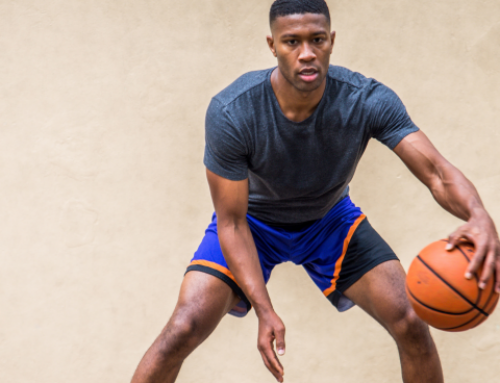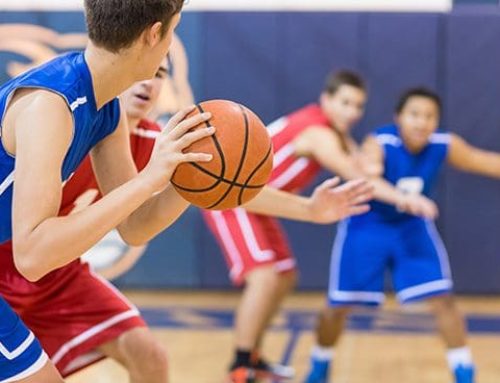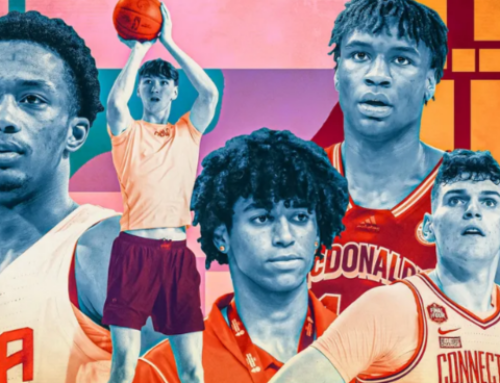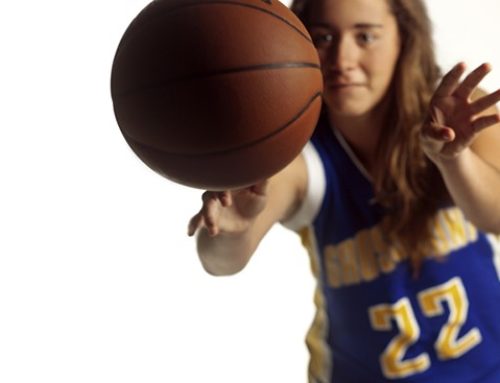How to Pick the Right Basketball Shoe for You
Finding the right basketball shoe can make a big impact on your performance, believe it or not. I used to think a shoe was just a shoe, and that if you could score and defend, it didn’t matter what was on your feet. The older I get and more time I spend around the game, the more I’ve realized that your shoe is actually very important.
There are probably more shoe options than ever right now, and the seemingly endless amount of choices can be overwhelming. To make it even tougher, shoe prices are at an all-time high, and customers struggle to find bang-for-your-buck products that deliver great performance without breaking the bank.
As a strength coach, players I work with in the weight room often opt to lift in their basketball shoes, which is not always the best option for strength training. We often get into discussions of what the best footwear is for lifting weights, but end up on the same topic for on-court performance. “Coach, what are the best kicks to play in?” This question sparked the idea of putting together this guide. It call comes down to who you are, how you play, what you need and what you like.
Consider this a resource for helping you find your best basketball shoe!
Performance Pillars
In terms of on-court performance, there are four categories I feel have the largest impact on the shoe’s worth. Those are: support, traction, comfort and aesthetics.
Support is the shoe’s ability to bear the weight, shape and activity of an athlete during training and competition. You want the shoe to support you without taking away the function of your feet.[youtube video=”xw6vgJd79TE”]
Checklist:
- Heel: You do not want the heel cup to collapse or lack structural integrity. The heel should be stable and form-fitting.
- Midfoot: You want a pliable but supportive midfoot. The shoe should not bend in half easily, but needs to have slight flexibility.
- Toe: The toe box should perform within the natural functionality of your toes, with good flexibility and range of motion.
- Ankle: If the material covers the ankle (mid and high tops) make sure that it adds to the function of the shoe, rather than limiting ranges of motion to a detriment.
- Laces: I prefer flat laces rather than round, as I believe they come untied far less often, but as long as the laces can be securely fastened, beyond that is just personal preference.
Not every shoe is going to nail it in all of these categories, but finding one that checks most (if not all) of these boxes is going to ensure a stable and supportive shoe.
Traction is the shoe’s ability to grip the playing surface and provide proprioceptive feedback to the athlete. You want the shoe to provide the proper traction for your style of play.
[youtube video=”fRx1s0Nlt5U”]Checklist:
- Pattern: You want a pattern that will not collect dust from playing surfaces, or if it does, one that is easy to clean mid-game.
- Shape: You want shoes that enhance or support the natural arch of the foot and responds well to the playing surface.
- Material: Again, you want a sole made of something that will not collect debris, but rather repel it as you play on many different surfaces.
Traction is not vital for all athletes, depending on your style of play, but it is still a large piece of finding the right basketball shoe. As you examine the bottoms of the shoe, take note of the condition of the shoe before and after you try it on and walk around the store. If there is a noticeable amount of change, it may not have the best traction.
Comfort is the shoe’s ability to be worn without pain, discomfort or distraction of physical wellness. You want a shoe you can wear for long periods of time.[youtube video=”jkFLtoCUkyk”]
- Width: This is personal preference, but generally, you want a shoe to be snug without being terribly difficult to get in/out of.
- Tightness: This is also personal preference, but generally, you want a shoe that allows you to alter tightness via straps or laces. Tightness may need to be changed pre, during or post game for various reasons.
- Cushion: If the shoe does not feel good on your feet, it’s not going to be a great shoe for you. Cushion, or lack thereof, is often a deciding factor when it comes to comfort.
Unlike traction and support, comfort is almost 100% personal preference. Comfort is pretty much up to the athlete and what they like or what they feel is best suited to them. Just because someone tells you a shoe is supposed to be “comfortable” doesn’t mean that will be the case for you, as it depends entirely on your experience.
Aesthetics are not just the appearance of the shoes, but also why they look that way and what purpose the style of the shoe can serve.[youtube video=”bHl2QGzbYOc”]
- Colorways: This is by far the least important factor on this list, but it has to be covered. The colorway is simply the color you buy the shoe in. Colorways don’t affect physical performance, but can maybe impact the mental side of things. If you like your shoe and feel confident in them, then that is one less thing to worry about on court.
- Materials: Shoes made of high-quality materials will delay wear and tear or breakdown as the shoe ages. This may affect the price point, but think of this purchase as an investment. One pair of shoes at $160 that lasts 12 months is better than two pairs of shoes at $110 a piece that last 6 months each.
- Durability: Try to avoid shoes with small superfluous details that cause the price to raise without effecting performance. An example would be non-durable shoe with a gold plated logo that will wear off over time, at the price of a premium shoe. Get what will last.
As far as colorways go, that’s on the athlete. But in terms of materials and durability —and ultimately price—try to use all of these checklist items to see how many checks you can make and get the best shoe for your money.
Choosing the Shoe
[youtube video=”BTyqAH8hZKw”]Now that you have a little background on some of the criteria to look for, it’s time to decide on the best pair for you.
Three major elements of this decision are your:
- Body Type
- Playing Style
- Personal Preference
Body Type
There are many different body types in the game of basketball, but narrowing things down to three major frames can help you make a decision.

- Ectomorph: Extremely lean, small joints, minimal muscle mass and slightly more prone to injury. Examples include: Brandon Jennings, Kevin Durant, Lonzo Ball and Steph Curry.
- Mesomorph: Athletic, strong and above-average muscle mass. Examples include: LeBron James, Steven Adams, Dwight Howard and Eric Bledsoe.
- Endomorph: Stocky frame, moderate muscle mass and body fat and slightly soft build. Examples include: Al Jefferson, Zach Randolph, Raymond Felton and Jabari Parker.
As you can see, you can be an elite level player with any of these body styles. Some shoes work better for certain body types. Adding context of playing style to the equation can make it even easier to choose.
Playing Style
There are many styles of play, but narrowing it down to the most common styles is useful for the purpose of this guide. The main playing styles are:
- Ball Handler/Facilitator: This is a player who typically touches the ball on every possession and has his/her hands in on every play on both ends of the court.
- Shooter: This is a player with lights-out accuracy on their jumper. They come off a lot of screens, cut a lot, move off-ball a lot and most of all… shoot a lot.
- Slasher and/or Defender: A slasher and a defender go in the same category because they are both extremely active and athletic. This is a demanding position that demands a lot from the athlete and shoe.
- Post Player: Post players, 4’s, 5’s and stretch 4’s who like to get in the paint, are players who spend a lot of their game in the trenches putting in work surrounded by trees.
Playing style along with body type can give you a really good idea of what you should look for in your shoe. Of course, all of the performance features listed above are important, but if I could only tell you to focus on one thing, here’s a quick breakdown of each combo.
Ectomorphs that are:
- Ball Handlers: Support – Smaller primary ball handlers need to support to make up for lack of support via strength.
- Shooters: Traction – Traction is huge for coming off screens, cutting and pull-up jumpers.
- Slashers/Defenders: Traction – Need traction to get in and out of cuts, jumps and sprints in a really active position.
- Post Players: Support – Post players with frail frames will need additional support to prevent injury down in the paint.
Mesomorphs that are:
- Ball Handlers: Durability – These players will probably play most of the game and need a shoe to support that task.
- Shooters: Traction – Traction is huge for coming off screens, cutting and pull-up jumpers.
- Slashers/Defenders: Support – This is a strong, agile athlete with extremely high demands on both ends of the court. Support is going to be key in performance optimization and injury prevention.
- Post Players: Comfort – Big athletes playing big minutes in the paint will need their feet to be well taken care of to be successful.
Endomorphs that are:
- Ball Handlers: Traction – Less athletic guards need shoe traction to make up for any lack of speed & agility.
- Shooters: Comfort – A less athletic shooter is getting more kick-outs than double screens so make sure he/she is comfy and ready to shoot.
- Slashers/Defenders: Traction – Need traction to get in and out of cuts, jumps and sprints in a really active position.
- Post Players: Comfort – These are seriously large players who need to make sure those feet don’t create orthopedic issues with the rest of the body.
Again, this is not the only thing you need to think about. This is simply what I would prioritize in the decision-making process. All things matter, including your personal preferences. If you’re an ectomorph post player, you may need shoe support. But if you hate mid and high tops because they make your feet hurt, use your best judgement and try to find support in a lower shoe.
All of the performance characteristics listed above matter. You just have to use critical thinking to assess what your body type, playing style and personal taste will handle the best.
Remember, if you’re looking at an NBA superstar’s signature shoe, that shoe is made for that player. Sure, it’s available for the public, but it’s tailored to that player’s game and their needs. If yours are similar, it’ll work for you as well.
For example, Steph Curry is an ectomorph ball handler with a history of ankle injuries. You can see that in his signature line, because most of the shoes are mid or high tops with a lot of support. Conversely, Kevin Durant is more of an ectomorph slasher/scorer. His signature line lacks the support of Curry, but has far better traction to better suit his style of play.
Some signature shoes will be outliers to the info we covered above due to that NBA star’s style of play, body type or personal needs. In general, I feel confident that this guide can point you in the right direction of what to look for depending on what you need and what you want out of a basketball shoe.
Photo Credit: skynesher/iStock
RECOMMENDED FOR YOU
MOST POPULAR
How to Pick the Right Basketball Shoe for You
Finding the right basketball shoe can make a big impact on your performance, believe it or not. I used to think a shoe was just a shoe, and that if you could score and defend, it didn’t matter what was on your feet. The older I get and more time I spend around the game, the more I’ve realized that your shoe is actually very important.
There are probably more shoe options than ever right now, and the seemingly endless amount of choices can be overwhelming. To make it even tougher, shoe prices are at an all-time high, and customers struggle to find bang-for-your-buck products that deliver great performance without breaking the bank.
As a strength coach, players I work with in the weight room often opt to lift in their basketball shoes, which is not always the best option for strength training. We often get into discussions of what the best footwear is for lifting weights, but end up on the same topic for on-court performance. “Coach, what are the best kicks to play in?” This question sparked the idea of putting together this guide. It call comes down to who you are, how you play, what you need and what you like.
Consider this a resource for helping you find your best basketball shoe!
Performance Pillars
In terms of on-court performance, there are four categories I feel have the largest impact on the shoe’s worth. Those are: support, traction, comfort and aesthetics.
Support is the shoe’s ability to bear the weight, shape and activity of an athlete during training and competition. You want the shoe to support you without taking away the function of your feet.[youtube video=”xw6vgJd79TE”]
Checklist:
- Heel: You do not want the heel cup to collapse or lack structural integrity. The heel should be stable and form-fitting.
- Midfoot: You want a pliable but supportive midfoot. The shoe should not bend in half easily, but needs to have slight flexibility.
- Toe: The toe box should perform within the natural functionality of your toes, with good flexibility and range of motion.
- Ankle: If the material covers the ankle (mid and high tops) make sure that it adds to the function of the shoe, rather than limiting ranges of motion to a detriment.
- Laces: I prefer flat laces rather than round, as I believe they come untied far less often, but as long as the laces can be securely fastened, beyond that is just personal preference.
Not every shoe is going to nail it in all of these categories, but finding one that checks most (if not all) of these boxes is going to ensure a stable and supportive shoe.
Traction is the shoe’s ability to grip the playing surface and provide proprioceptive feedback to the athlete. You want the shoe to provide the proper traction for your style of play.
[youtube video=”fRx1s0Nlt5U”]Checklist:
- Pattern: You want a pattern that will not collect dust from playing surfaces, or if it does, one that is easy to clean mid-game.
- Shape: You want shoes that enhance or support the natural arch of the foot and responds well to the playing surface.
- Material: Again, you want a sole made of something that will not collect debris, but rather repel it as you play on many different surfaces.
Traction is not vital for all athletes, depending on your style of play, but it is still a large piece of finding the right basketball shoe. As you examine the bottoms of the shoe, take note of the condition of the shoe before and after you try it on and walk around the store. If there is a noticeable amount of change, it may not have the best traction.
Comfort is the shoe’s ability to be worn without pain, discomfort or distraction of physical wellness. You want a shoe you can wear for long periods of time.[youtube video=”jkFLtoCUkyk”]
- Width: This is personal preference, but generally, you want a shoe to be snug without being terribly difficult to get in/out of.
- Tightness: This is also personal preference, but generally, you want a shoe that allows you to alter tightness via straps or laces. Tightness may need to be changed pre, during or post game for various reasons.
- Cushion: If the shoe does not feel good on your feet, it’s not going to be a great shoe for you. Cushion, or lack thereof, is often a deciding factor when it comes to comfort.
Unlike traction and support, comfort is almost 100% personal preference. Comfort is pretty much up to the athlete and what they like or what they feel is best suited to them. Just because someone tells you a shoe is supposed to be “comfortable” doesn’t mean that will be the case for you, as it depends entirely on your experience.
Aesthetics are not just the appearance of the shoes, but also why they look that way and what purpose the style of the shoe can serve.[youtube video=”bHl2QGzbYOc”]
- Colorways: This is by far the least important factor on this list, but it has to be covered. The colorway is simply the color you buy the shoe in. Colorways don’t affect physical performance, but can maybe impact the mental side of things. If you like your shoe and feel confident in them, then that is one less thing to worry about on court.
- Materials: Shoes made of high-quality materials will delay wear and tear or breakdown as the shoe ages. This may affect the price point, but think of this purchase as an investment. One pair of shoes at $160 that lasts 12 months is better than two pairs of shoes at $110 a piece that last 6 months each.
- Durability: Try to avoid shoes with small superfluous details that cause the price to raise without effecting performance. An example would be non-durable shoe with a gold plated logo that will wear off over time, at the price of a premium shoe. Get what will last.
As far as colorways go, that’s on the athlete. But in terms of materials and durability —and ultimately price—try to use all of these checklist items to see how many checks you can make and get the best shoe for your money.
Choosing the Shoe
[youtube video=”BTyqAH8hZKw”]Now that you have a little background on some of the criteria to look for, it’s time to decide on the best pair for you.
Three major elements of this decision are your:
- Body Type
- Playing Style
- Personal Preference
Body Type
There are many different body types in the game of basketball, but narrowing things down to three major frames can help you make a decision.

- Ectomorph: Extremely lean, small joints, minimal muscle mass and slightly more prone to injury. Examples include: Brandon Jennings, Kevin Durant, Lonzo Ball and Steph Curry.
- Mesomorph: Athletic, strong and above-average muscle mass. Examples include: LeBron James, Steven Adams, Dwight Howard and Eric Bledsoe.
- Endomorph: Stocky frame, moderate muscle mass and body fat and slightly soft build. Examples include: Al Jefferson, Zach Randolph, Raymond Felton and Jabari Parker.
As you can see, you can be an elite level player with any of these body styles. Some shoes work better for certain body types. Adding context of playing style to the equation can make it even easier to choose.
Playing Style
There are many styles of play, but narrowing it down to the most common styles is useful for the purpose of this guide. The main playing styles are:
- Ball Handler/Facilitator: This is a player who typically touches the ball on every possession and has his/her hands in on every play on both ends of the court.
- Shooter: This is a player with lights-out accuracy on their jumper. They come off a lot of screens, cut a lot, move off-ball a lot and most of all… shoot a lot.
- Slasher and/or Defender: A slasher and a defender go in the same category because they are both extremely active and athletic. This is a demanding position that demands a lot from the athlete and shoe.
- Post Player: Post players, 4’s, 5’s and stretch 4’s who like to get in the paint, are players who spend a lot of their game in the trenches putting in work surrounded by trees.
Playing style along with body type can give you a really good idea of what you should look for in your shoe. Of course, all of the performance features listed above are important, but if I could only tell you to focus on one thing, here’s a quick breakdown of each combo.
Ectomorphs that are:
- Ball Handlers: Support – Smaller primary ball handlers need to support to make up for lack of support via strength.
- Shooters: Traction – Traction is huge for coming off screens, cutting and pull-up jumpers.
- Slashers/Defenders: Traction – Need traction to get in and out of cuts, jumps and sprints in a really active position.
- Post Players: Support – Post players with frail frames will need additional support to prevent injury down in the paint.
Mesomorphs that are:
- Ball Handlers: Durability – These players will probably play most of the game and need a shoe to support that task.
- Shooters: Traction – Traction is huge for coming off screens, cutting and pull-up jumpers.
- Slashers/Defenders: Support – This is a strong, agile athlete with extremely high demands on both ends of the court. Support is going to be key in performance optimization and injury prevention.
- Post Players: Comfort – Big athletes playing big minutes in the paint will need their feet to be well taken care of to be successful.
Endomorphs that are:
- Ball Handlers: Traction – Less athletic guards need shoe traction to make up for any lack of speed & agility.
- Shooters: Comfort – A less athletic shooter is getting more kick-outs than double screens so make sure he/she is comfy and ready to shoot.
- Slashers/Defenders: Traction – Need traction to get in and out of cuts, jumps and sprints in a really active position.
- Post Players: Comfort – These are seriously large players who need to make sure those feet don’t create orthopedic issues with the rest of the body.
Again, this is not the only thing you need to think about. This is simply what I would prioritize in the decision-making process. All things matter, including your personal preferences. If you’re an ectomorph post player, you may need shoe support. But if you hate mid and high tops because they make your feet hurt, use your best judgement and try to find support in a lower shoe.
All of the performance characteristics listed above matter. You just have to use critical thinking to assess what your body type, playing style and personal taste will handle the best.
Remember, if you’re looking at an NBA superstar’s signature shoe, that shoe is made for that player. Sure, it’s available for the public, but it’s tailored to that player’s game and their needs. If yours are similar, it’ll work for you as well.
For example, Steph Curry is an ectomorph ball handler with a history of ankle injuries. You can see that in his signature line, because most of the shoes are mid or high tops with a lot of support. Conversely, Kevin Durant is more of an ectomorph slasher/scorer. His signature line lacks the support of Curry, but has far better traction to better suit his style of play.
Some signature shoes will be outliers to the info we covered above due to that NBA star’s style of play, body type or personal needs. In general, I feel confident that this guide can point you in the right direction of what to look for depending on what you need and what you want out of a basketball shoe.
Photo Credit: skynesher/iStock











